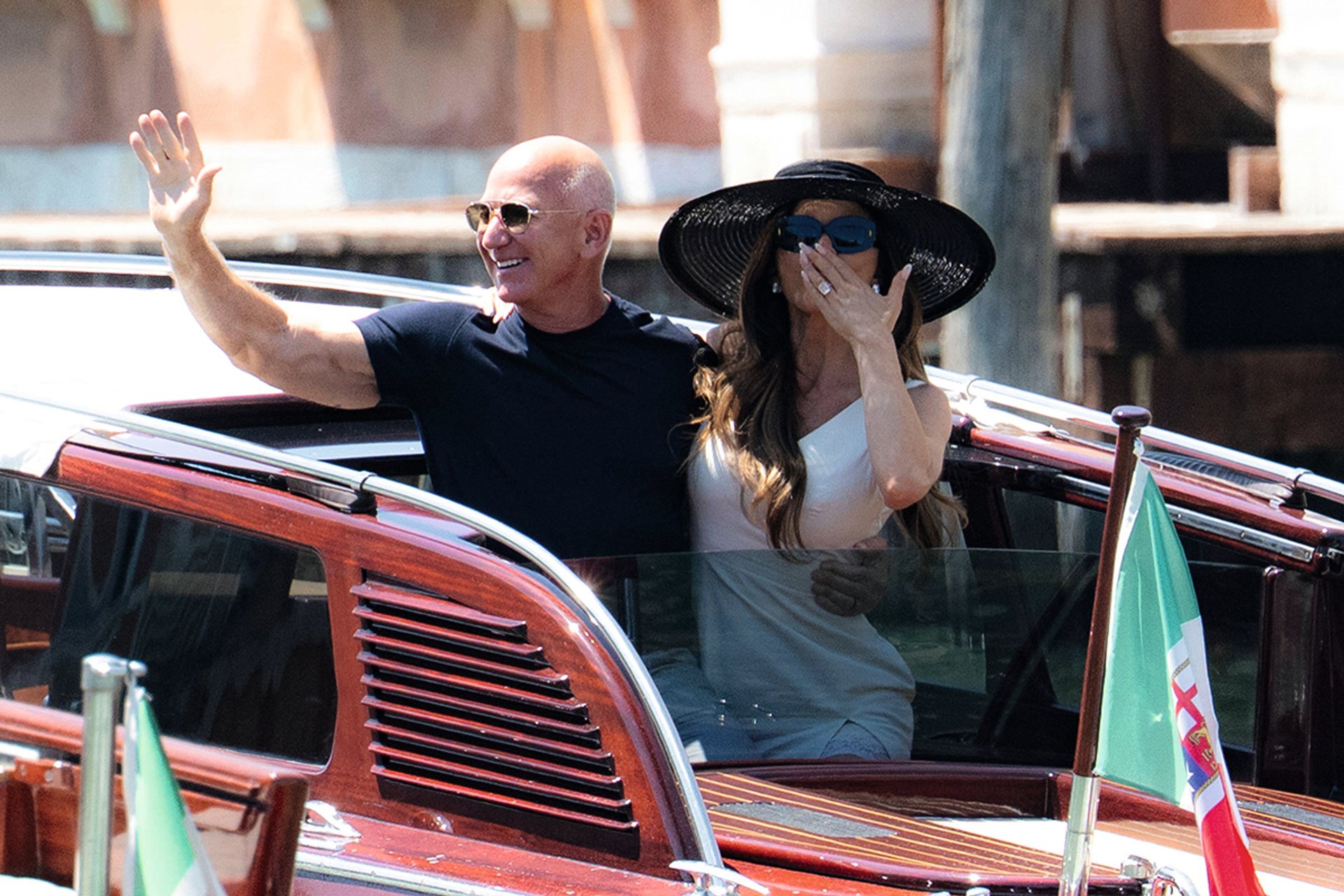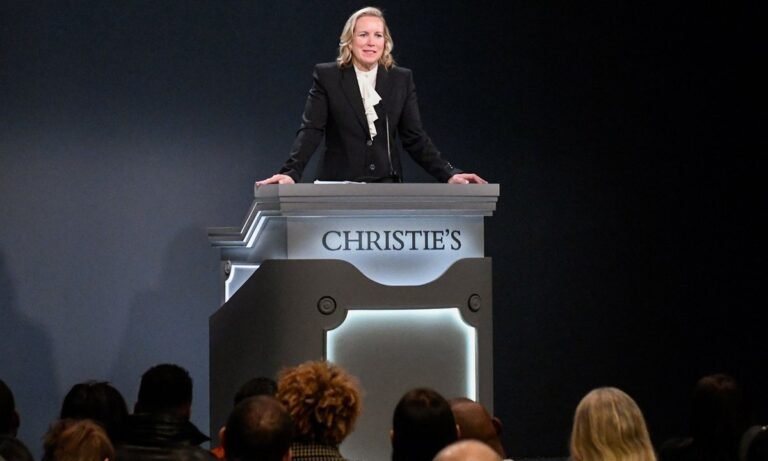“In the first six months as CEO, my focus has been on ensuring continuity and a global commitment to our strategy,” says Bonnie Brennan, Christie’s recently appointed chief executive, of the auction house’s sales figures for the first half of 2025—a year marked by “forever” wars and geopolitical turmoil.
Christie’s raised a projected $2.1bn in the first half of 2025—pretty much the same as last year. Sales in the 20th- and 21st-century art category were down 2%, but luxury, significantly, was up 29%. The headline numbers were almost identical at Sotheby’s, whose first-half sales raised $2.2bn, just slightly down on the $2.3bn in the equivalent period last year.
In the absence of growth, the art market now has “continuity”, according to Brennan. This is, of course, far preferable to the 22% drop in sales Christie’s registered in the first half of 2024. So has the decline finally bottomed out?
“It’s a two-to-three-year blip—I’ve seen five of these in my career,” says Philip Hoffman, who founded The Fine Art Group advisory firm in 2001, after working as chief financial officer at Christie’s. “But I can’t see too much changing in the next 12 months.”
According to Hoffman, high transaction costs have been deterring the wealthy from buying and selling high-value art at auction. “Clients are thinking in a more financial way than they used to,” Hoffman says. In June it was announced that he and four other art market grandees had launched New Perspectives Art Partners, focusing on lower-risk, lower-cost private sales for wealthy collectors.
But if you are wealthy and thinking in a more financial way, why think about art at all? That is the elephant-sized question in the middle of this particular room.
The latest data compiled by the seasoned art market analyst Michael Moses, the co-founder of the Mei Moses Art Index—based on the results of 58,000 Old Master, Impressionist, Modern and contemporary works bought at auction since 1970 and resold at Sotheby’s, Christie’s and Phillips in the first half of 2025—show that more than 50% of lots sold for prices that represented negative compound annual returns. The majority of auction sales in the second half of 2024 had also dipped into negative territory. Moses describes these auction losses as “the worst overall financial performance in the 21st century”, adding that “recent outsized returns of stocks, gold and Bitcoin may be what is holding the art market back”.
Crypto trumps art
During the first half of this year, the S&P 500 index of US stocks rose 5.1%, gold 25.1% and Bitcoin 9.1%, according to Yahoo Finance data. By mid-July, BlackRock’s Bitcoin Trust Exchange Traded Fund (ETF), a financial vehicle that uses investors’ capital to buy Bitcoin, had attracted $84bn in funds under management, says the Financial Times. That inward investment in just one fund is $26.5bn more than Art Basel and UBS’s estimate for the total value of global art market sales last year.
The recent stampede into crypto-, tech- and AI-related stocks might indicate where investors think easy money is to be made. But what about the age-old power of art as a status symbol? Surely that is still a reason why the wealthy should spend at auctions and art fairs?
Perhaps some insight into how our algorithm overlords view art can be gleaned by Google’s AI Overview of the ultimate status symbols for the wealthy. Listed are items such as private jets, high-end cars, exclusive travel experiences, luxury pet services and even the “bookshelf wealth” of a curated library. Art is not mentioned.

A Canaletto Venice painting sold for $43.9m in July following Jeff Bezos’s Venice wedding Sipa US/Alamy Stock Photo
But exceptional one-off sales are still happening. In July, just a few days after Jeff Bezos’s $50m wedding to Lauren Sánchez in Venice, Christie’s sold Canaletto’s Venice, the Return of the Bucintoro on Ascension Day, formerly owned by Robert Walpole, Britain’s first prime minister, for a record $43.9m. With its impressive scale, grandiose subject and prestigious provenance, this painting was an obvious trophy collectable. But so too were the “long-lost” Rosebud sledge from Citizen Kane that sold for $14.7m at Heritage Auctions and the juvenile Ceratosaurus fossil that fetched $30.5m at Sotheby’s in the same month. For the ultra-wealthy, the world is a luxury playground and trophy purchases such as these are among its toys.
In the meantime, the prominent dealer Tim Blum has closed his gallery, telling Artnews the “system” hasn’t worked for years and that this year’s Art Basel “sucked”, even though he said he sold 85% of his stand in advance of the fair. “We didn’t have a single meaningful conversation Thursday through Sunday,” Blum added.
Deepening the malaise, the galleries Venus Over Manhattan and Clearing have also closed, and the Art Dealers Association of America’s New York fair in October has been cancelled.
Blum’s comments suggest the major fairs are now primarily social events for a small cohort of wealthy individuals who enjoy the international collecting lifestyle. Some art is sold, but mostly online before the fair. Money is spent at the event, but mostly by galleries hosting dinners for clients and by ticket-buying visitors.
Art Basel is part of what its parent company MCH Group’s “anchor shareholder” James Murdoch characterised in a 2023 interview with Artnet News as the “travelling circus” model. Like a Formula One Grand Prix, a branded international art fair creates a fun “broader moment” for a destination that “could be really lucrative for the city”, before moving on, according to Murdoch. In May, MCH announced Qatar had been added to the Art Basel portfolio of venues. But unlike the clowns and trapeze artists of a traditional circus—and Formula One drivers—art dealers have to pay to perform.
So, if owning a Picasso, Warhol or Amoako Boafo no longer makes easy money for a wealthy individual, or even confers much in the way of status, and international art fairs are now part of the private equity-owned experience economy (Frieze announced in May that it had been bought by Ari Emanuel, the former chief executive of the Hollywood entertainment behemoth Endeavor), where does this leave the evolving landscape of the art market?
For the Brussels-based collector Alain Servais, the trade’s various sub-markets will continue to contract. “Overall revenues will keep reducing but not especially the number of artworks sold,” Servais tells The Art Newspaper. The “artberg” of ultra-expensive Modern and classic contemporary works accumulated over the years by boomer collectors does not appeal to younger generations. Only masterpieces will sell well. The speculative and financialised side of the market “is going and will go more because few can deny the opacity and lack of liquidity of art, making it improper as a financial asset”, adds Servais, who thinks prices are too high because the “infrastructure of the current market is too expensive”. The market for “real” art—rather than the undemanding “zombie” art produced for fairs—is the “only sustainable way forward”, Servais says.
Marc Spiegler, the former global director of Art Basel, agrees that trying to sell art as a financial asset has been a disaster. Writing for The Business of Fashion, he proposes an alternative future for the art market, urging it to “rapidly pivot” towards selling art as an “Instagrammable, sapiosexy pleasure for the wealthy, high IQ set, who get excited about culture, complex ideas, access to artists and the possibility of signalling all of that”.
There you have it. The trade should concentrate on selling art as status symbols to the richest, brainiest 0.01%, who, as influential neo-reactionary thinkers such as Curtis Yarvin and Nick Land predict, will rule what is left of our world once democracy is eradicated and the so-called Dark Enlightenment prevails. Fortunes could be made selling endorphin-stimulating art to decorate the walls of tech billionaires’ post-apocalypse bunkers.
Ready for Art Basel Auckland?

